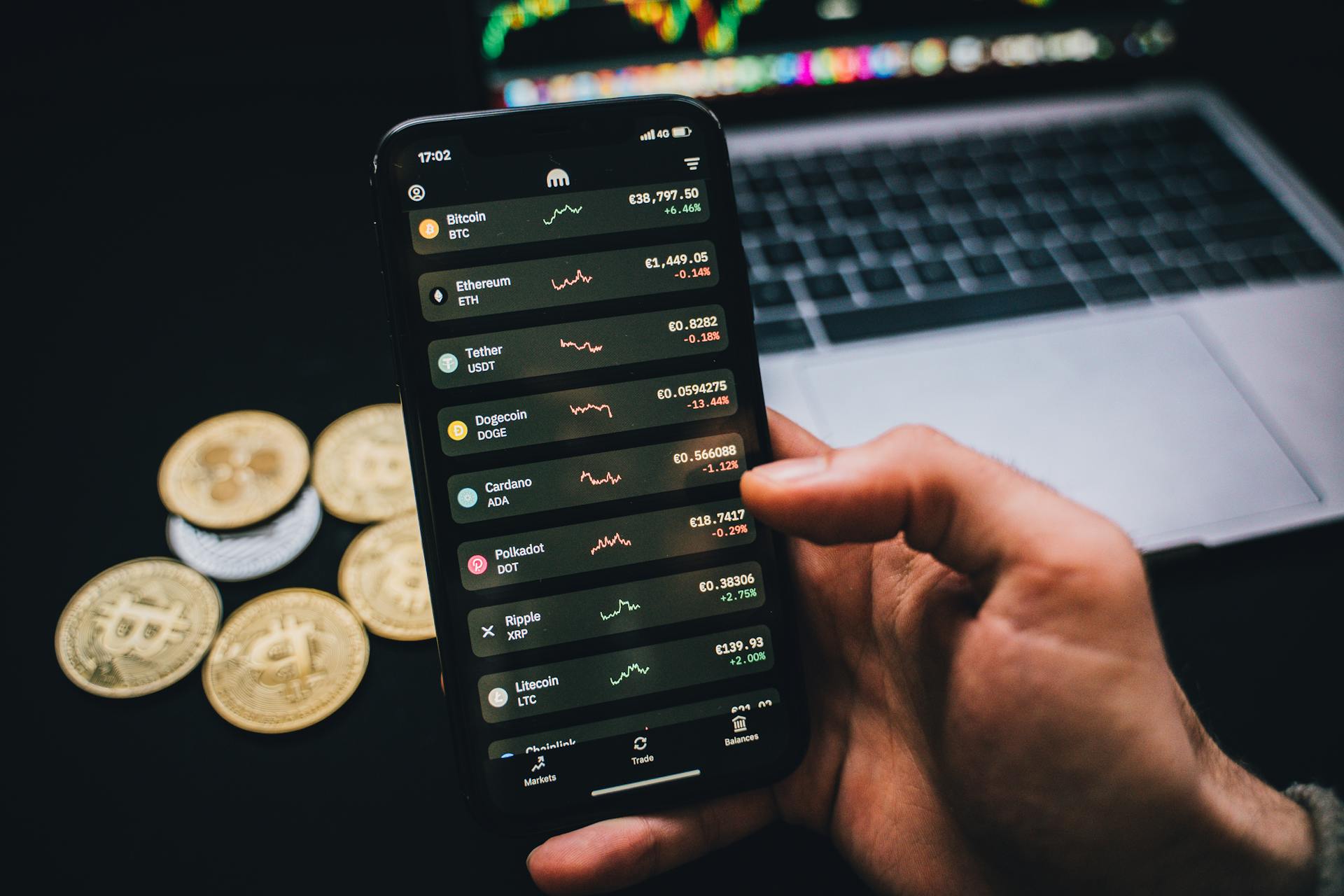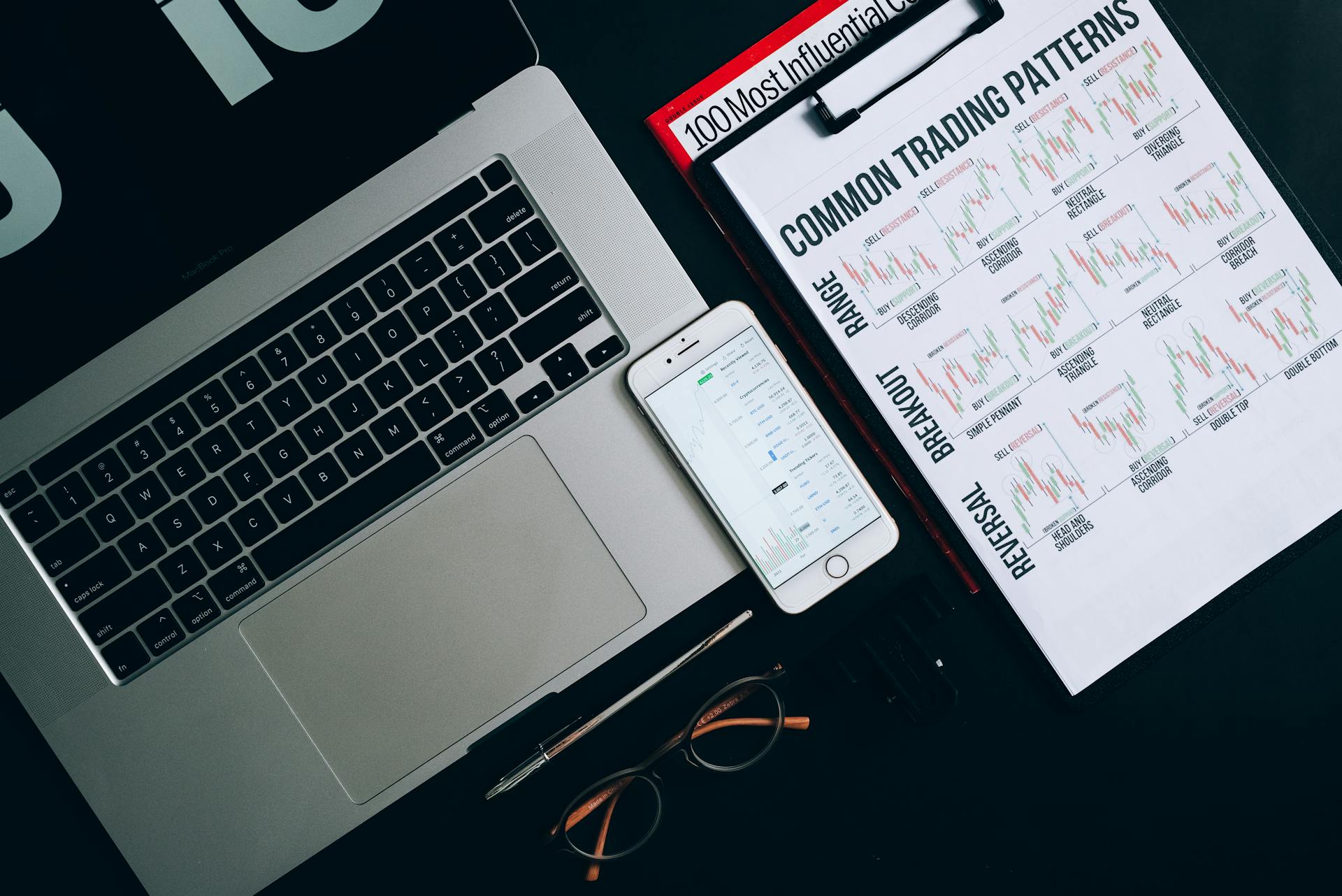
Algorithmic trading strategies can be a game-changer for both beginners and pros. By automating trades based on predefined rules, you can reduce emotional decision-making and increase trading efficiency.
One popular strategy is trend following, where you ride the trend by buying or selling assets based on their momentum. This approach is often used in futures and forex markets.
Trend following can be implemented using various indicators, such as moving averages and relative strength index (RSI). These indicators help identify the direction and strength of the trend.
Beginners can start with simple strategies like mean reversion, where you buy undervalued assets and sell overvalued ones. This approach is often used in stock markets.
Mean reversion can be implemented using statistical models, such as the Arima model, which predicts future price movements based on past data.
Take a look at this: Quantitative Hedge Fund Strategies
History of Algorithmic Trading
The concept of algorithmic trading has a fascinating history that spans several decades. Computerization of the order flow in financial markets began in the early 1970s with the introduction of the "designated order turnaround" system (DOT) by the New York Stock Exchange.
For another approach, see: Stock Order Book
The 1980s saw significant advancements in algorithmic trading with the introduction of SuperDOT in 1984, an upgraded version of DOT that allowed for electronic routing of orders to trading posts.
Program trading emerged in the 1980s, defined by the New York Stock Exchange as an order to buy or sell 15 or more stocks valued at over US$1 million total. This marked a significant shift towards automated trading strategies.
The 1980s also saw the rise of index arbitrage, a strategy that used program trading between the S&P 500 equity and futures markets. Portfolio insurance was designed around the same time, using a computer model based on the Black–Scholes option pricing model to create a synthetic put option on a stock portfolio.
The introduction of these automated trading strategies was not without controversy, as they were blamed by many for exacerbating or even starting the 1987 stock market crash.
For more insights, see: Algo Trading Automated Software
Types of Algorithmic Trading
There are several types of algorithmic trading, each with its own unique approach and goals.
Market making algorithms are designed to provide liquidity to the market by placing both buy and sell orders, effectively making a market in a particular security. They aim to profit from the bid-ask spread, which is the difference between the price at which a buyer is willing to buy and the price at which a seller is willing to sell.
Arbitrage algorithms, on the other hand, look for mispricings in the market by exploiting differences in prices across multiple exchanges or markets. They aim to profit from the price discrepancies by buying in one market and selling in another.
See what others are reading: Do Debt Collectors Buy Debt
Market Making
Market making is a type of algorithmic trading that involves placing limit orders to capture the bid-ask spread.
Automated Trading Desk, which was bought by Citigroup in July 2007, has been an active market maker, accounting for about 6% of total volume on both NASDAQ and the New York Stock Exchange.
By placing limit orders above the current market price or below it, market makers can capture the difference between the bid and ask prices, providing a source of income.
Market makers can be active on multiple exchanges, making them a significant presence in the market.
However, market makers also carry the same risks and uncertainties as any other form of trading, and traders may still experience losses even with a market making system.
Broaden your view: Equity Market Making
Making Money with?
Algorithmic trading can provide a more systematic and disciplined approach to trading, which can help traders to identify and execute trades more efficiently than a human trader could.
It's possible to make money with algorithmic trading, but it's not a guarantee. Algorithmic trading carries the same risks and uncertainties as any other form of trading, and traders may still experience losses even with an algorithmic trading system.
Using ProRealTime, you can create your own trading algorithms from scratch, which can operate according to your exact specifications. This means you have full control over your trading decisions.
If this caught your attention, see: Traders Day
You can also use pre-made algorithms available on the MT4 marketplace, which offers a wide range of off-the-shelf solutions. These algorithms have already been created and refined by experienced traders.
The development and implementation of an algorithmic trading system can be costly, and traders may need to pay ongoing fees for software and data feeds. However, with the right tools and resources, you can make algorithmic trading work for you.
You might enjoy: How Do Bond Traders Make Money
Strategies and Techniques
Algorithmic trading strategies can be categorized into three main types: price action, technical analysis, and combination strategies. A price action strategy looks at previous open and close or session high and low prices to trigger a buy or sell order.
A technical analysis strategy relies on technical indicators such as Bollinger bands, stochastic oscillators, MACD, and the relative strength index to trigger buy and sell orders. With this strategy, you'd create an algorithm to act on the parameters of these indicators.
Suggestion: Algorithmic Trading and Quantitative Strategies

Statistical arbitrage is another type of strategy that involves making trades based on deviations from statistically significant relationships. This strategy can be applied in all asset classes and can be used to generate alpha. Market timing strategies, on the other hand, are designed to generate alpha and involve using technical indicators such as moving averages and pattern recognition logic implemented using finite-state machines.
Here are some common techniques used in algorithmic trading:
- Backtesting: Refine your algorithms against historical data to establish the best combination of buy or sell parameters.
- Forward testing: Run the algorithm through an out of sample data set to ensure the algorithm performs within backtested expectations.
- Live testing: Compare actual live trades with both the backtested and forward tested models.
- Percentage of Volume (POV): Send partial orders according to the defined participation ratio and according to the volume traded in the markets.
These techniques can help you refine your algorithms and improve their performance. By using a combination of these techniques, you can create a robust algorithmic trading strategy that generates consistent returns.
Index Fund Rebalancing
Index fund rebalancing is a strategy that creates profitable opportunities for algorithmic traders. The rebalancing process involves adjusting the portfolio to match the new prices and market capitalization of the underlying securities in the stock or other index that the fund tracks.
Algorithmic traders capitalize on expected trades that offer 20 to 80 basis points profits, depending on the number of stocks in the index fund just before rebalancing. This profit margin can add up over time.

Index funds have defined periods of rebalancing, which creates a predictable pattern that traders can exploit. By initiating trades via algorithmic trading systems, traders can execute high-frequency trades in a timely manner and secure the best prices.
The speed of high-frequency trades has increased significantly, from milliseconds to microseconds or even nanoseconds. This allows traders to react quickly to market changes and capitalize on opportunities before others can.
Here's a rough breakdown of the estimated losses incurred by passive investors due to trading ahead of index fund rebalancing:
These losses are significant and can have a lasting impact on investment returns. It's essential to be aware of these risks and consider strategies to mitigate them.
Delta-Neutral Strategies
Delta-neutral strategies are a type of portfolio that remains unchanged due to small changes in the value of the underlying security.
This strategy typically involves options and their corresponding underlying securities, where positive and negative delta components offset each other.
Delta-neutral trading strategies are also known as a portfolio strategy consisting of multiple positions with offsetting positive and negative deltas.
The overall delta of the assets in question totals zero, making the portfolio relatively insensitive to changes in the value of the underlying security.
In finance, delta-neutral strategies are used to reduce risk and increase potential returns by balancing out the positive and negative effects of changes in the underlying security.
By combining options and underlying securities, traders can create a portfolio that is less affected by market fluctuations.
Delta-neutral strategies have been used in proven mathematical models, such as the delta-neutral trading strategy.
This strategy allows traders to trade on a combination of options and the underlying security, making it a popular choice for algorithmic trading.
Discover more: Algorithmic Trading Winning Strategies and Their Rationale
Statistical Arbitrage
Statistical arbitrage is a set of high-frequency trading strategies that involve making trading decisions based on deviations from statistically significant relationships.
These strategies can be applied in all asset classes and are estimated to generate annual aggregate profits exceeding $21 billion.

Statistical arbitrage strategies are often used in the foreign exchange market, where they can be used to exploit differences between market prices and those implied by models.
Covered interest rate parity is one example of a statistical arbitrage strategy that involves four transactions to guarantee a risk-free profit.
This strategy can be replicated using models of greater complexity involving many more than four securities, allowing for even greater profit potential.
Statistical arbitrage strategies can be applied in a wide range of markets, including stocks, bonds, and futures, and can be used to identify profitable opportunities in all asset classes.
Algorithmic trading allows traders to implement these strategies quickly and efficiently, using models to identify statistically significant relationships and make trades in real-time.
The speed of high-frequency trades has increased dramatically in recent years, with trades now being executed in microseconds or even nanoseconds.
Supplement Your Strategy
Supplementing your existing strategy can make all the difference in achieving your trading goals. Refining your algorithms against historical data can establish the best combination of buy or sell parameters.

Backtesting is a crucial step in refining your algorithms. This involves using historical data to test and refine your strategies. According to Example 4, backtesting allows you to refine your algorithms against historical data to establish the best combination of buy or sell parameters.
You can also supplement your existing strategy by finely tuning your risk management. Using algorithms to implement stops and limits on your behalf can help minimize losses and maximize gains. Example 5 highlights the importance of risk management, stating that finely tuning your risk management by using algos to implement stops and limits on your behalf can help achieve your trading goals.
By supplementing your strategy with backtesting and risk management, you can create a more robust and effective trading system. This can help you stay ahead of the market and achieve your financial goals.
Broaden your view: Algo Trading Algorithms
Scalping
Scalping is a liquidity provision strategy where traders aim to earn the bid-ask spread by quickly buying and selling securities.
This procedure is based on the idea that price movements are usually less than the spread, allowing traders to profit from these small price changes.
Scalpers often use sophisticated trading systems and technology to execute trades rapidly, typically within minutes or less.
In fact, market makers, who are essentially specialized scalpers, trade in much higher volumes than individual scalpers and are subject to specific exchange rules.
For instance, NASDAQ requires each market maker to post at least one bid and one ask at a certain price level to maintain a two-sided market for each stock.
Market makers' minimum quote obligations ensure that there's always a buyer and a seller in the market, providing liquidity to traders.
Market Timing
Market timing strategies are designed to generate alpha and typically use technical indicators like moving averages and pattern recognition logic.
Backtesting is the first stage, where the algorithm is simulated through an in-sample data period to determine the most optimal inputs.
Optimization is performed to reduce the chance of over-optimization, which can be done by modifying inputs +/- 10%, shmooing the inputs in large steps, or running Monte Carlo simulations.
Ensuring slippage and commission is accounted for is also crucial to get accurate results.
Forward testing involves running the algorithm through an out-of-sample data set to ensure it performs within backtested expectations.
Live testing is the final stage, where actual trades are compared with both the backtested and forward tested models.
Metrics such as percent profitable, profit factor, maximum drawdown, and average gain per trade are compared to evaluate the algorithm's performance.
Worth a look: Hft Trading Algorithm
High-Frequency
High-Frequency trading is a form of algorithmic trading characterized by high turnover and high order-to-trade ratios.
High-frequency trading firms account for 73% of all equity trading volume in the U.S., despite representing only 2% of the approximately 20,000 firms operating today.
The first successful HFT strategy was made by Renaissance Technologies, and it's been a subject of intense public focus since the 2010 Flash Crash.
Consider reading: Best Brokerage Firms for Day Trading
Many HFT firms are market makers and provide liquidity to the market, which has lowered volatility and helped narrow bid–offer spreads, making trading and investing cheaper for other market participants.
There are four key categories of HFT strategies: market-making based on order flow, market-making based on tick data information, event arbitrage, and statistical arbitrage.
All portfolio-allocation decisions in HFT are made by computerized quantitative models, which can simultaneously process volumes of information that ordinary human traders cannot.
You might like: How to Do Hft Trading
Trend-Following Strategies
Trend-following strategies are a popular choice among algorithmic traders. They follow trends in moving averages, channel breakouts, price level movements, and related technical indicators.
These strategies are easy to implement through algorithmic trading because they don't involve making predictions or price forecasts. Trades are initiated based on the occurrence of desirable trends.
One popular trend-following strategy is using 50- and 200-day moving averages. This strategy is straightforward to implement through algorithms without getting into the complexity of predictive analysis.
Expand your knowledge: Currency Market Trends
Here are some common trend-following strategies:
- Moving Average Crossover: This strategy involves buying or selling a security when its short-term moving average crosses above or below its long-term moving average.
- Channel Breakout: This strategy involves buying or selling a security when it breaks out of a established price channel.
- Price Level Movement: This strategy involves buying or selling a security when its price reaches a certain level.
Trend-following strategies can be implemented using modern programming languages, such as C+ or Python, which are efficient in processing high volumes of data.
Volume-Weighted Average Price (VWAP)
The Volume-Weighted Average Price (VWAP) strategy breaks up a large order and releases dynamically determined smaller chunks of the order to the market using stock-specific historical volume profiles.
This approach aims to execute the order close to the volume-weighted average price (VWAP).
The strategy uses historical data to determine the optimal time and volume to release each chunk, minimizing market impact and achieving a better average price.
By breaking up the order into smaller chunks, VWAP helps to reduce the market's reaction to the large order, allowing for a more efficient execution.
The use of stock-specific historical volume profiles helps to identify the most active trading periods and adjust the order release accordingly.
This approach can be particularly effective in markets with high trading volumes, where the VWAP can be a reliable indicator of the market's average price.
Short Selling
Short selling is a trade strategy that doesn't require a directional bias, allowing you to run long/short or market neutral strategies.
Alpaca's Trading API makes it possible to execute short selling trades without worrying about market fluctuations.
You can trade without predicting which way the market will move, giving you more flexibility in your investment approach.
The Trading API allows you to focus on other aspects of your strategy, like risk management and diversification.
A different take: Gme Short Squeeze
Frequently Asked Questions
Is algorithmic trading really profitable?
Algorithmic trading can be profitable, offering a systematic approach to trading that may outperform human traders. However, success depends on various factors, including strategy, execution, and market conditions
What is algorithm trading?
Algorithm trading involves using computer programs to automatically execute trades based on predefined instructions. This automated trading approach uses algorithms to make trades at optimal times, minimizing human error and maximizing efficiency
How much money do algorithmic traders make?
Algorithmic traders can earn an estimated total pay of $197,566 per year, with an average salary of $129,238 per year. Discover the lucrative world of algorithmic trading and learn how to unlock these high earning potential opportunities.
What does an Algorithmic Trader do?
Algorithmic traders use computer programs to take advantage of small market movements that humans might miss. They often have access to significant resources, which can influence market trends.
Is algo trading legal?
Algo trading is legal in India, applicable to both retail and institutional investors
Sources
- https://en.wikipedia.org/wiki/Algorithmic_trading
- https://www.investopedia.com/articles/active-trading/101014/basics-algorithmic-trading-concepts-and-examples.asp
- https://corporatefinanceinstitute.com/resources/equities/algorithmic-trading/
- https://www.ig.com/en/trading-platforms/algorithmic-trading
- https://alpaca.markets/algotrading
Featured Images: pexels.com

